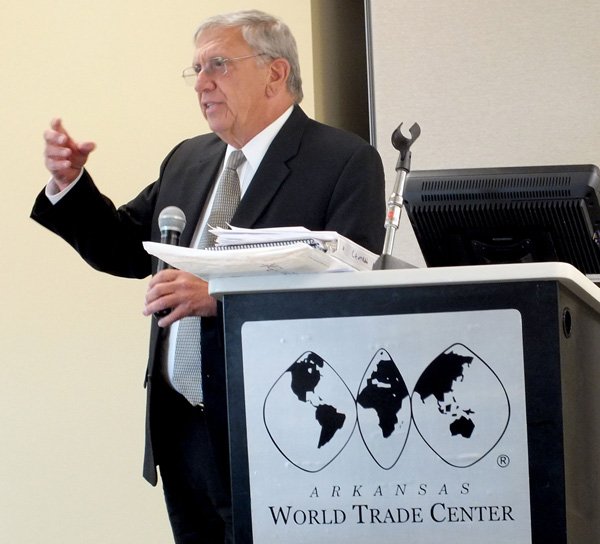ROGERS — Economic growth in Latin America opens doors to Arkansas companies.
“When the U.S. went into the recession it showed a lot of companies the importance of being in new markets,” said Sean Kelley, director of the U.S. Export Assistance Center in Little Rock.
Kelley was one of the speakers at a luncheon Thursday highlighting export opportunities in Latin America. About two dozen people attended the event sponsored by the World Trade Center Arkansas in Rogers.
Arkansas exports hit $7.6 billion in 2012, according to the International Trade Administration. Canada is the state’s largest importer, accounting for 21.7 percent, or $1.7 billion, of all Arkansas exports. Mexico ranked second with $845 million.
By The Numbers
Export Arkansas
• 1,627 companies exported from Arkansas in 2010
• 78 percent of exporting companies were small and medium sized
• $7.6 billion Arkansas exports in 2012
• $1.7 billion Arkansas exports to Canada in 2012
• $845 million Arkansas exports to Mexico in 2012
• $360 million Arkansas exports to Brazil in 2012
Source: International Trade Administration
Graham Catlett, chairman of the Arkansas District Export Council, said many factors play into the decision of where to trade, including duties, trade agreements, customer base, demographics and ease of transportation.
“When you look at Latin America you should look first at Mexico,” he said.
Factors such as geography, the provisions of the North American Free Trade Agreement and Mexico’s economy make it a good trading partner, Catlett said.
“From Little Rock I can get to Mexico City faster than I can get to Los Angeles,” he said.
The North American Free Trade Agreement started in 1994 between the United States, Canada and Mexico. It was designed to increase trade by reducing or eliminating restrictions on commerce such as tariffs and import quotas.
Trade is also opening up with Colombia. The U.S-Colombia Trade Promotion Agreement took effect May 15, 2012, and removed tariffs on 80 percent of U.S. consumer and industrial exports, Kelley said.
Dan Hendrix, president and chief executive officer of the World Trade Center Arkansas, said trade agreements are opening up markets. Rice exports to Colombia grew by 300 percent following implementation of the trade agreement, he said.
“It’s been proven that trade agreements increase the export trade and creates a level playing field,” he said.
Brazil, with the world’s seventh-largest economy, is another good export target because of strong economic growth fueled by a substantial oil discovery off the country’s southeastern coast, Kelley said.
“It’s a large market and worth the effort to get into,” Kelley said.
Don Callan, president of PerioSeal started his business in 2004 after designing and patenting a dental implant. The Little Rock-based company has done business all around the world, but Callan said he was forced to look for new foreign market after the European financial crisis that started in 2009.
PerioSeal entered the Latin American market about 18 months ago and is still early in the process. Callan has distributors in Peru and Colombia.
“As countries progress, health care is one of the major growth markets,” he said. “It is an untapped market.”
Lanny Ashlock attended Thursday’s luncheon to see if Latin America was a good option for soybean farmers. Ashlock is project manager for the Arkansas Soybean Promotion Board.
Arkansas farmers export 60 percent of their crops, he said. Soybean sales hit a record $2 billion in 2012.
“Mexico already imports a lot of U.S. soybeans and I wanted to know what other opportunities may be down there,” he said.
Ashlock said he now sees other Latin American countries, including Brazil, as potential markets.
“It’s all about adding value to the market,” Ashlock said.

